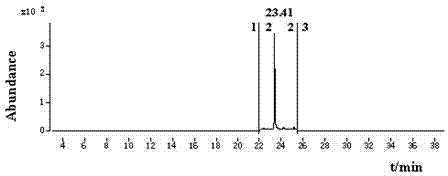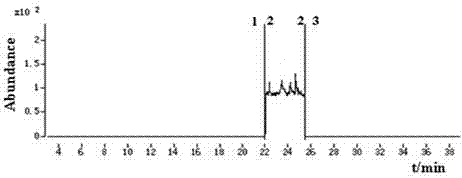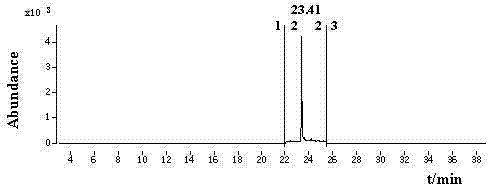Method for measuring residual amount of chlorantraniliprole in vegetables and fruits
A technology for the determination of chlorantraniliprole and its determination method, which is applied in the field of determination of chlorantraniliprole residues, can solve the problems of time-consuming, restricting the application of LC-MS/MS, and high price, so as to avoid matrix interference , easy operation and high sensitivity
- Summary
- Abstract
- Description
- Claims
- Application Information
AI Technical Summary
Problems solved by technology
Method used
Image
Examples
Embodiment 1
[0036] Example 1: Detection of chlorantraniliprole residues in apples
[0037] (1) Sample pretreatment
[0038] Weigh 10.0 g of well-mixed apples into a 50 mL centrifuge tube, accurately add 20 mL of acetonitrile, homogeneously extract for 1 min, add 3 g of anhydrous magnesium sulfate and 2 g of sodium chloride, vortex for 1 min, and centrifuge at 7000 r / min for 5 min. After centrifugation, take 6mL of acetonitrile extract and transfer to a solution containing 900mg anhydrous magnesium sulfate, 300mg C 18 and 150mg PSA in a centrifuge tube, vortex for 1min, and centrifuge at 5000r / min for 5min. Take 4mL of supernatant in a nitrogen blowpipe, dry it with nitrogen at 40°C, add 1mL of acetone / n-hexane mixed solvent with a volume ratio of 1 / 1 to dissolve the residue, vortex and mix evenly to pass through the membrane, then transfer it to an injection bottle for GC - EI-MS determination.
[0039] (2) Preparation of standard working solution
[0040] Accurately weigh 25±0.1mg of...
Embodiment 2
[0066] Example 2: Detection of chlorantraniliprole residues in green beans
[0067] (1) Sample pretreatment
[0068] Weigh 10.0 g of well-mixed green beans into a 50 mL centrifuge tube, accurately add 20 mL of acetonitrile solution containing 1% acetic acid, extract homogeneously for 1 min, add 3 g of anhydrous magnesium sulfate and 2 g of sodium acetate, vortex for 1 min, and 7000r / min Centrifuge for 5min. After centrifugation, take 6mL of acetonitrile extract and transfer to a solution containing 900mg anhydrous magnesium sulfate, 300mg C 18 and 150mg PSA in a centrifuge tube, vortex for 1min, and centrifuge at 5000r / min for 5min. Take 4mL of the supernatant in a nitrogen blowpipe, dry it with nitrogen at 40°C, add acetone / n-hexane mixed solvent with a volume ratio of 1 / 1 to dissolve the residue, vortex and mix well, then transfer it to an injection bottle for GC-EI - MS determination.
[0069] (2) Preparation of standard working solution
[0070] Dilute the 10μg / mL st...
PUM
| Property | Measurement | Unit |
|---|---|---|
| Column length | aaaaa | aaaaa |
| The inside diameter of | aaaaa | aaaaa |
| Film thickness | aaaaa | aaaaa |
Abstract
Description
Claims
Application Information
 Login to View More
Login to View More - R&D
- Intellectual Property
- Life Sciences
- Materials
- Tech Scout
- Unparalleled Data Quality
- Higher Quality Content
- 60% Fewer Hallucinations
Browse by: Latest US Patents, China's latest patents, Technical Efficacy Thesaurus, Application Domain, Technology Topic, Popular Technical Reports.
© 2025 PatSnap. All rights reserved.Legal|Privacy policy|Modern Slavery Act Transparency Statement|Sitemap|About US| Contact US: help@patsnap.com



